 |
||
|
||
| ||
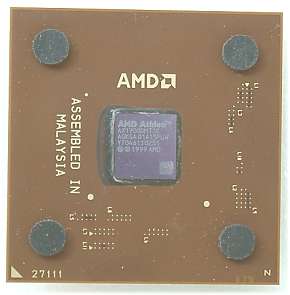 Although the AMD Athlon XP 1900+ announced recently doesn't differ much from the Athlon XP 1800+ we keep on comparing the performance of the most powerful processors from AMD and Intel. Test system configuration:
Software:
Boards
EPoX EP-8KHA+This board was already reviewed before, and if you read it you can omit several paragraphs below.  The company has just added "+" to the board's name demonstrating a higher performance of the new chipset from VIA. Earlier "plus" models from EPoX always had a UATA/66 (100) IDE RAID. This is the first production board on the VIA Apollo KT266A without it. This board differs from its predecessor 8KHA just in the chipset and in a higher-quality AC'97 codec from Avance Logic. The today's board packed in a semitransparent plastic box is supplied with 40- and 80-conductor cables for IDE devices, an FDD cable and a bracket with two additional USB connectors for the rear computer panel. A thick board description gives you all necessary instructions for installation of the board and drivers. A folding short manual is written in 6 languages. Besides, there is a CD with drivers and a modest set of freeware programs, among which are Adobe Acrobat Reader 4.05, Norton Antivirus 2001, PCCillin 2000 and Norton Ghost 6.03. Besides, there is a utility for measuring a processor frequency from DOS or Windows - Boostek. 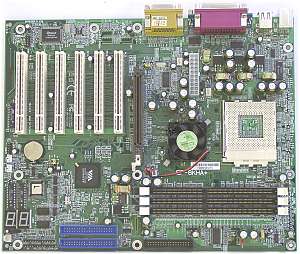 CD-in and AUX-in connectors are placed in front of the first PCI slots - it has nearly become a standard for the manufacturers, but it isn't convenient for assemblers. Besides, the company has decided to save on plastic for these connectors. The cables will undoubtedly fall out from such connectors. On the other hand, there is a clamp on the AGP connector and an AAVID's cooler on the north bridge of the chipset. Besides, there are two standard 7-segment LEDs for monitoring the POST procedure. The codes displayed on them are described in the manual. The feed circuits have 12 LowESR capacitors of 2200uF each. 2 switches are meant for clearing the CMOS and for choosing the base frequency - 100 or 133 MHz. All other settings can be made from the BIOS Setup. The BIOS is based on the v6.00 from Award and includes a great deal of possibilities for adjusting memory timings, AGP and PCI buses operation and a possibility to distribute manually interrupts among PCI slots. The FSB frequency can be changed from 100 to 200 MHz in 1 MHz steps. The core voltage can be changed +/- 0.1V in 0.025V steps and the memory voltage can be lifted by 0.7V from the rated value in 0.1V increments. ASUS P4T-E ASUSTeK has redesigned a board on the i850 for a new socket. No secret that a lot of manufacturers cut development costs by changing only electric circuits for a new socket leaving an old PCB design. Why did ASUS redesign it is unclear as the ASUS P4T had no significant flaws. The box contains a user's manual in English, a short installation manual in 11 languages, an 80-conductor ATA66/100 cable, a 40-conductor ATA/33 one, an FDD one, a bracket with two USB ports for a rear computer panel, two C-RIMM modules and a CD. The disc comes with a rich set of software: Adobe Acrobat Reader 5.0, ASUS Update, CyberLink programs (PowerPlayer SE, PowerDVD Trial Version, VideoLive Mail), ASUS Hotkey, Intel LDCM (LANDesk Client Manager), PCCilllin 2000, ASUS PCProbe and a proprietary screensaver. 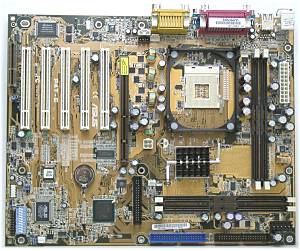 The board differs much from its predecessor and other boards on this chipset. The memory slots are placed on two sides of the socket which is here turned at 90 degrees relative to its usual position. The IDE connectors are thus located on the edge of the board while the FDD one is at right angle to them, between the memory slots and the AGP one. The engineers installed the proprietary own monitoring chip - ASUS AS99127F. Dip-switches can help change a FSB frequency and a CPU multiplier. They can also be changed in the BIOS Setup. There are switches with traditional functions such as audio codec on/off, computer start-up from a USB keyboard&mouse etc. The Clear CMOS switch is absent but new ASUS boards don't need it as this operation is implemented automatically. The BIOS is based on the v. Medallion 6.00 from Award. Here you can, for example, change a FSB frequency in 1 MHz from 100 to 227 MHz and a CPU multiplier, set a correlation of FSB and memory frequencies etc., manually distribute interrupts between PCI slots etc. Besides, you can find here a great deal of settings for AGP, PCI and memory buses. Well, this board offers quite good speed characteristics and runs flawlessly. Tests3DMark 2001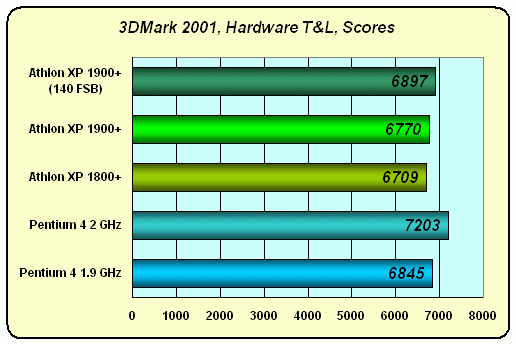  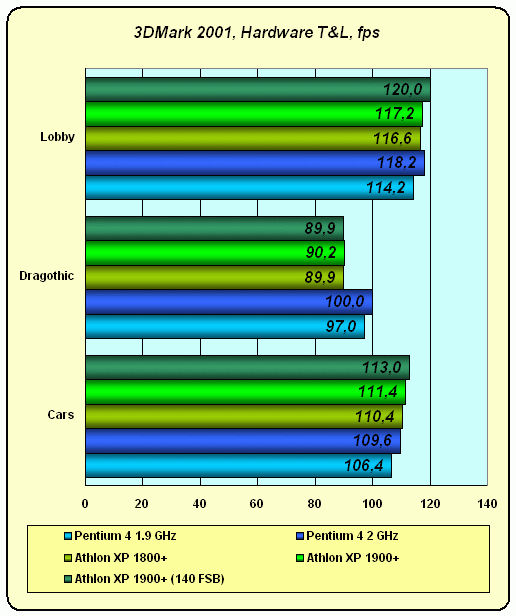 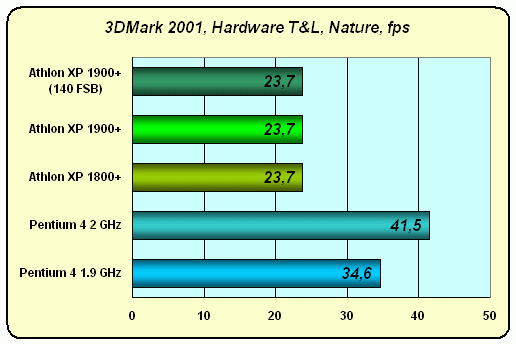 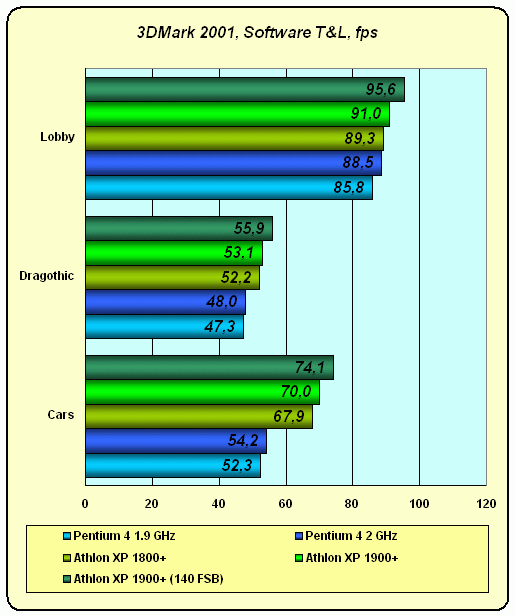  The Pentium 4 takes a great lead in the Nature with Software T&L and Hardware T&L, and it is interesting that the gap is larger when it should be smaller as the hardware T&L unit of the video card is enabled! But what if a key to the victory is not the processor itself? We used to equate RDRAM and Pentium 4. Although this memory type is actually used only in Pentium 4 based systems, we shouldn't put an equals sign between the processor and the memory subsystem. Quake III  This is a favorite test of Intel :) The top Pentium 4 was never beaten by any other processors in this test. However, this time the Athlon XP 1900+ comes very close to the leader. eTestingLabs Winstone 2001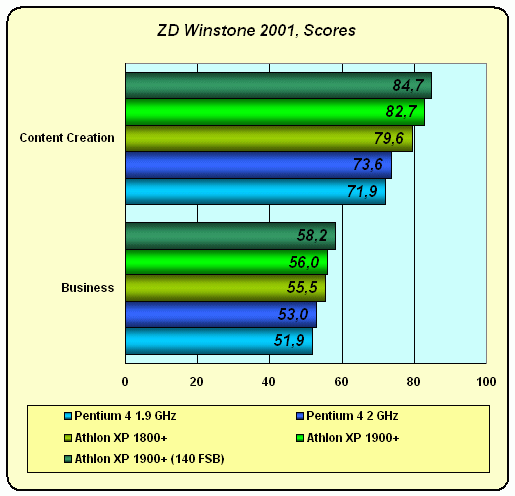 And this one is a favorite test of AMD :) As always, the Athlon clobbers the Pentium 4. SPEC Viewperf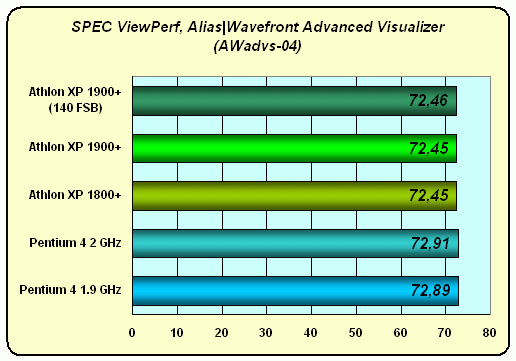 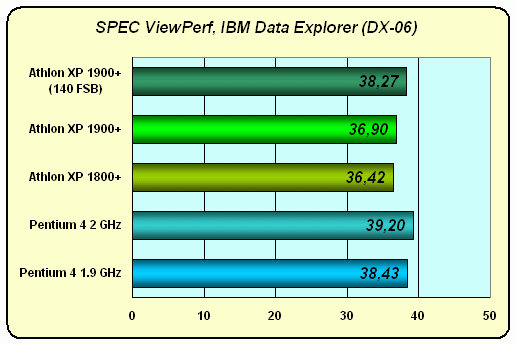  The Athlon XP 1900+ goes on a par with the Pentium 4 in two subtests and loses a little in the third one. Unfortunately, we failed to check up our hypothesis this time (the good scores of the Pentium 4 are achieved thanks to optimization of the the NVIDIA Detonator drivers for the Pentium 4 SSE2). However, soon we will get a speedy OpenGL accelerator - ATI Radeon 8500, and then find out whether our hypothesis is true. 3DStudio MAX In the 3DStudio MAX the AMD Athlon easily outperforms the Pentium 4; and it's interesting that even the Athlon XP 1800+ can beat the Pentium 4 2 GHz :) It is one more example of a program oriented to a traditional core architecture. Expendable As you know, Expendable is a game with a chaotic algorithm which gives bad headache to the long pipeline of the Pentium 4. Here the Pentium needs almost a twice higher frequency to beat the Athlon :) DroneZMark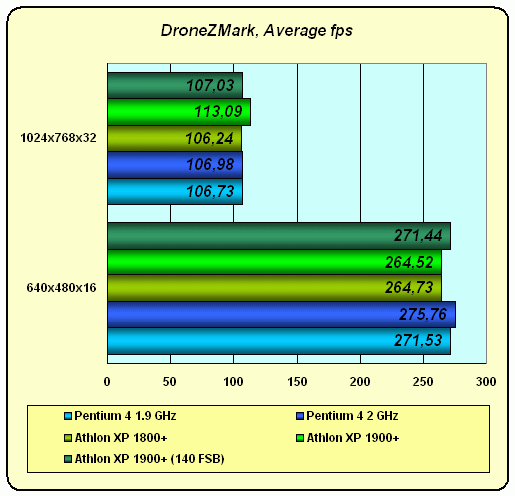 This test mainly loads a video system. As you can see, the Athlon XP 1800+ and the Athlon XP 1900+ go on a par at the rated FSB frequency and the Athlon XP 1900+ outruns the former at the FSB frequency equal to 140 MHz. The AMD CPU systems need a higher speed of the processor <-> memory system to catch up with the Pentium 4. SYSmark 2001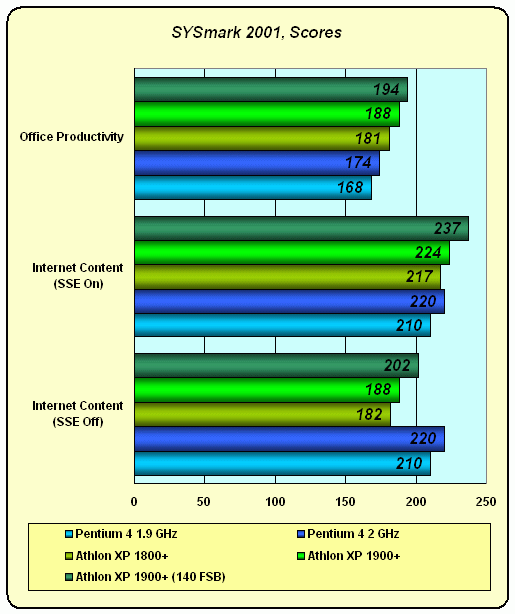 Well, the Athlon XP benefits a lot from the SSE support. WAV to MP3, VideoCD to MPEG4 and archiving 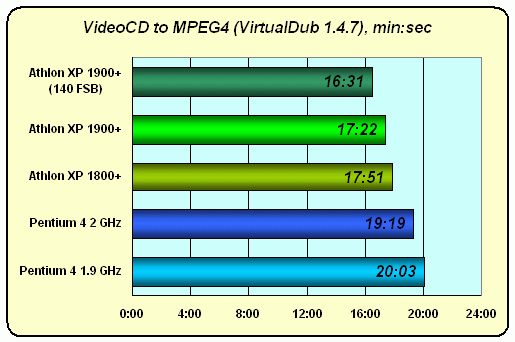  All AMD processors cope excellently with the archiving, and when the powerful FPU appeared in Athlon the multimedia data compression became cooler as well. By the way, the victory of the Athlon in all three tests is connected with the fact that all applications except the WinAce are developed by enthusiasts who usually don't meddle with optimizations for SSE2. But it doesn't mean that the tests are not objective as the most of users prefer free software to the commercial one if they are similar in functions. ConclusionOn the whole, according to the average results of all the tests used today, the AMD Athlon XP 1900+ is approximately equal to the Intel Pentium 4 2 GHz in performance. The Athlon XP 1900+ may be even a bit faster but you will never feel it. Besides, these processors sometimes differ considerably but the number of such applications which like one CPU and hate the other are almost equal. However, the price difference between the systems on VIA Apollo KT266A
+ PC2100 DDR + Athlon XP 1900+ and on Intel i850 + PC800 RDRAM + Pentium
4 2 GHz is so considerable that the Athlon XP seems to be very promising
considering its SSE support... Though the Pentium 4 "Northwood" and i845
+ DDR may change the situation. At present, a 0.18-micron Willamette coupled
with the PC800 RDRAM yields in the price/performance ratio. But now even
Intel doesn't stake on this combination.
Write a comment below. No registration needed!
|
Platform · Video · Multimedia · Mobile · Other || About us & Privacy policy · Twitter · Facebook Copyright © Byrds Research & Publishing, Ltd., 1997–2011. All rights reserved. | ||||||||||||||||||||||||||||||||||||||||||||||||||||||||||||||||||||||||||